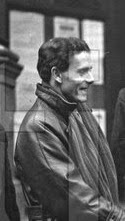When, a few years ago, I bought a copy of Ernst Toller’s Brokenbrow (1926) for its brilliant illustrations by George Grosz, I didn’t take much notice of the bookplate. Recently, I took another look and discovered that it was made for Rudolph Messel, Oxford friend of Evelyn Waugh in the early twenties and one of the lesser known members of the 'Hypocrites Club'.
Born in 1905, the son of wealthy stockbroker Harold George Messel, art was part of Rudolph’s heritage. Famous stage designer Oliver Messel was his cousin and his aunt Maud was daughter of the celebrated Punch cartoonist Linley Sambourne. In 1918, when he was 13 he lost his mother. On his father’s death two years later Rudolph may have become a ward of his uncle Leonard, who in 1915 had inherited Nymans, in Sussex, from his father Ludwig (also a stockbroker ).While Leonard was transforming the gardens of Nymans and filling the mansion with costly art works from around Europe, his nephew Rudolph was living an effete life at Oxford as a member of the notorious Hypocrites Club, whose more famous members included Evelyn Waugh, Terence Greenidge and Lord David Cecil. In 1926, aged 21, Rudolph stayed for a few days on Lundy with Greenidge, probably on the recommendation of Waugh, who had visited the island two years earlier with some fellow Hypocrites. Greenidge and Messel had interests in common . Both liked dogs and both were keen on film. The eccentric Greenidge was perhaps a little keener on dogs than was Messel and attracted attention on Lundy by a habit of kissing his pooch on the mouth.
As a student Rudolph boasted that he intended to write a full length study of film-making which he would call This Film Business. The book, duly published in1928, was advertised as the first serious study of the cinema. It was well received and is still highly regarded by cinema historians. Messel is known to have published just one other book, Refuge in the Andes (1939 ).

In Oct 1947, like his Oxford contemporary Betjeman before him, Messel married the daughter of a Field Marshall, in this case the Hon Judith Horatia Birdwood, daughter of Lord Birdwood, and the pair retired to live a life of rural bliss at the Victorian Ford House, Drewsteignton, on the edge of Dartmoor. It was Judith who designed the bookplate for her husband as a 1949 Valentine’s Day gift. The design consists of a cartouche bearing Messel’s initials around which are arranged symbolic images of his life. Going clockwise we see a typewriter followed by books, a bottle of Gordon’s gin, a tankard, a flagon of cider, a sheaf of corn and a harvest fork, a packet of cigarettes, and lastly, a sheet of music.
Messel died in 1958 at the early age of 53, possibly due to an over fondness for gin, cider and cigarettes. Oddly, Rudolph’s cousin Oliver features several times in Humphrey Carpenter’s The Brideshead Generation (1989), but there is no mention of Rudolph.
Today, you can buy Rudolph and Judith’s former home in Drewsteignton, albeit with several modern alterations that doubtless would not have met with their approval. With its 7 bedrooms, this Victorian mansion stands in extensive grounds, and can be had for a very reasonable £1.3M [RH]


This is driving me to recognise my lack of organisation and memory – I have a book….somewhere… with this bookplate but cannot find it. I will keep looking….
'This suspense is terrible. I hope it will last.'
Geoff
http://litlinks1.blogspot.co.uk/
Found it and it is 'Lord Arthur Savile's Crime and other Stories' by Oscar Wilde, Methuen 1909. Having looked closely at the books represented on the plate, they might all be by Messel himself.
Geoff
http://litlinks1.blogspot.co.uk/
Thanks Geoff. I couldn't get close enough to see if all the books in the bookplate are by Messel…the cigs are certainly Cork — probably cork-tipped!
I came across the R.PM. as a book reviewer and contributing editor under the name Rudolph Messel for the monthly journal Fact (1937-1939). If so he must have had moderately left wing phase in the 30s, as many did. It was trying to find out more about this person that led me to this site.
It also seems he published a novel in 1934 called: High Pressure. A novel. Now impossible to get hold of.
It seems likely they are the same person but I cannot claim absolute proof.
Very late to this, but Rudolph Messel also had a role as an archaeological benefactor in the very early 1930s. He funded his Oxford contemporary David Talbot Rice (1903-1972) – then a young Byzantinist, going on to to become an internationally-famous art historian and Late Antique archaeologist – to take part in the work inside the Bodrum Camii (a former church), in the Myrelaion district of Constantinople/Istanbul, revealing its tenth-century roots and a much earlier Late Roman building-complex.
I was tickled to see my father’s friendship with Rudolph mentioned. I am the daughter of Terence Greenidge and spent a weekend at Rudolph’s Devon mansion in the 1930s. I also met him at my mother’s house on occasion (my parents wer divorced). I was very impressed on my visit to Devon to be met by a liveried chauffeur with an electric car. My father was deeply upset by Rudolph’s untimely death.
Althea Richardson (nee Greenidge)